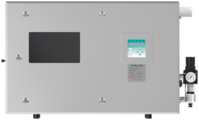Label Printer Solution for Zone 1/21 and Zone 2/22 Applications
The 6500 Series Purge and Pressurization System Enables Direct Printing in Hazardous Areas

The Application
One of the problems with printers installed in explosion-hazardous areas for quality control purposes is how to retrieve the label or paper from the machine, and get it into the operator’s hands. In Zone 1/Division 1 applications, this can be very difficult and inconvenient when explosionproof or flameproof types of protection are involved.
The Goal
The ability to print a label or document in time during operation, without compromising the hazardous area around the printer. The printer must be small and take up limited space in the area. In addition, many printers are unique to a process or operation and cannot be replaced by another printer. By converting the customer’s existing printers to Ex printers, a workflow redesign that would require a different printer is avoided.
The Solution

Side view of the 6500 series purge and pressurization system
The new solution from Pepperl+Fuchs makes it possible to bring a wide variety of printer models into hazardous areas easily and safely. In most cases, the printer model that has already been used in non-hazardous areas can be reused. Time-consuming software adjustments are a thing of the past.
Printers in an airtight enclosure filled with air or an inert gas are installed in an explosion-free zone. If the pressure inside the printer enclosure is at least 50 Pa (~0.5 mbar) higher than the ambient pressure, explosive gas-air mixtures are effectively prevented from entering the enclosure. After closing the enclosure door and switching on the supply voltage, there must be no explosive gases inside the enclosure. This is ensured by an automatic “pre-purge” phase, which purges the enclosure with air or inert gas to remove any explosive gases that may be present. A built-in type of protection Ex p controller inside the printer enclosure monitors and controls all necessary functions of the pressurized enclosure and automatically connects the supply voltage to non-Ex devices.
Technical Features
- Flexible enclosure design with viewing window
- Externally mounted controls for operating the printer
- Various mounting options, e.g. table mounting, on stand, with rollers, etc.
- International certifications: ATEX/IECEX Zone 1/21, 2/22, NEC Class/Div. (on request), UKCA (on request)
- Ambient temperature range 5 °C … 40 °C (depending on printer)
- Communication relay (optional)
The Benefits
Pepperl+Fuchs guarantees maximum operational reliability and minimum purging gas consumption by using the controller and sealing valve of the proven in-house brand Bebco EPS®. Creeping leakage rates, for example due to aging of the housing seals, cable glands, etc., are compensated by the automatic leakage compensation of the purging system. The concept offers the highest flexibility in realization: various printer models as well as windows and operating elements, such as buttons for line feed or print abort, are part of the standard configuration. Communication interfaces can be optionally implemented into the solution. In addition, the label roll fill level can be easily verified via the viewing window. Direct printing is now possible in hazardous areas without opening the enclosure door/flap. The models can be used worldwide, and standard versions are available with short delivery times.
At a Glance
- Preconfigured industrial printer solutions
- Fast manufacturing, ready to ship within a short time
- Designed for use in Zone 1 and Zone 2 environments
- Suitable for use in harsh industrial environments or pharmaceutical cleanrooms
- Special design with type of protection Ex p technology
- Stainless steel enclosure








 +82 2 34819494
+82 2 34819494